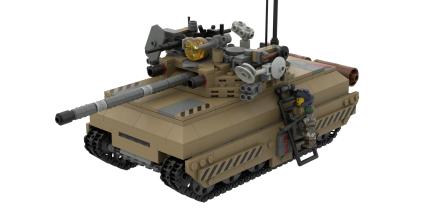L-325 Mastiff

The Lonbal-325 "Mastiff" Mobile Artillery Battery, Troop Transport, and Habitation Pod was the Main Battle-Tank of the EotLP during the Third Balkavanian War, where it first saw action, mainly against the Nakorentan Union's I-7 Quplon, or as a source of mobile direct artillery and Troop cover.
Development
Development on the L-325 began in 233, by the Lonbal Armour Corporation, a subsidiary of Lancer Technologies. Development was undertaken by a small team, many of whom had worked on the GIT-1760 “Buffalo” Tanks just a few years prior. Development was slow due to the small size of the team, as well as the numerous details that Emperor Sergio Ren mandated the tank must have. After the Smelly Cabbage Incident, development on the L-325 stalled, but was restarted in 240, with a much expanded team and budget. The first prototype was completed in 244, and underwent a series of tests that assessed its capabilities (see below). After passing the tests, the L-325 moved into production phase. 500 were constructed by 250. They were integrated into the Rennian Army throughout the next 5 years, as the Buffaloes were slowly phased out. A major update to the Mastiff came in 257, when an active countermeasure system was implemented onto all existing tanks, to prevent around 95% of all shots fired at the Mastiff from every coming into contact with the Armour of the Tank.
Testing
In 244, the first working prototype of the L-325 was tested rigorously by the EotLP Military to assess its capabilities in many areas, such as weapons, armour, versatility, mobility, habitability, survivability, and alternate functions. A two-day Weapons Test was summarized in the sentence:
Highly Accurate Weapons System. Danger to Crew Low. Reliability High. Destructive Power equally High.
Following that, the tank was crewed by two Buffalo Operators, and dispatched on a route through the Rural EotLP & Cklserolva. The crew's final rating of the tanks was:
The L-325 is highly maneuverable, and its speed is second to none. Onboard Guidance is completely reliable, whether accurate data is known or not. Internal space highly comfortable & spacious
Alternate Functions of the Mastiff were tested on the return journey, during which it acted as the basis for a pontoon bridge across a river, a troop transport, a mobile demolition team, and a logging vehicle. It fared extremely well in all situations, even the ones that the Lonbal Engineers had not prepared the tank for.
The survivability of the L-325 and its Armour were tested simultaneously, during live fire tests. 10 Buffalos lined up, and began to fire on the Mastiff, which was, at first, habited only by Dummies. However, once test results appeared satisfactory, engineers replaced the damaged armour, and a live-fire, live-target test began. 2 soldiers and 2 tank operators crowded into the tank's interior, and waited to be fired at by the Buffaloes. They carried out all the tasks easily, and as soon as the live fire test finished, they practiced 4 escape drills, all of which the Tank passed with flying colours. Finally, specialized Anti-tank weapons were tested against it. Although it eventually succumbed to 4 successive strikes of Armour-Piercing Rounds, and to 3 repeated, direct strikes from a mobile-anti tank weapons, the internals remained surprisingly intact, and it took 4 soldiers just 2 hours to replace the damaged armour. It took 4 trained personnel just 1:30:23.98 to replace the damaged armour. Finally, Anti-tank weapons were tested with live targets. Two volunteers were placed inside the Tank, which was then fired upon by Armour-piercing rounds as well as specialized anti-tank weapons. The crew survived the first hit from each weapon (each fired on a different side of the L-325) without any trouble, and the second hit caused only barely visible tremors in the tank. However, the third Armour-Piercing Round breached the tank's armour, lighting a small fire in the cabin. However, the L-325's automatic safety systems diffused the threat before the crew had time to start emergency exit procedures. After a careful review by the on-site engineers, the commander in charge declared that the test would finish, still with a live crew. The un-injured crew re-entered the Tank, which now had a hole in its right side. The mobile anti-tank RPG was fired on the left side, and struck a solid hit. The heavily repaired armour on the left side succumbed as well, and the explosive passed through the armour of the L-325, and detonated inside. The crew were in combat positions for the drill, and such positions protected them from almost all injuries. The inside of the tank was burned, and the crew sustained minor burns, but the shrapnel was dampened by another safety system, and the Crew members received a total of 3 shrapnel wounds, all of which were minor. Despite the repaired armour failing, it was attributed to faulty construction of the replacement armour, and improper repair procedures by the engineer division.
The tank was given a 99/100 rating overall, and was given the green light to move into production.